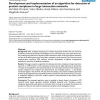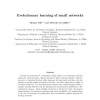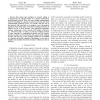79 search results - page 5 / 16 » Role of Function Complexity and Network Size in the Generali... |
BMCBI
2006
13 years 7 months ago
2006
Background: After complete sequencing of a number of genomes the focus has now turned to proteomics. Advanced proteomics technologies such as two-hybrid assay, mass spectrometry e...
COMPLEXITY
2008
13 years 7 months ago
2008
Results are presented of a simulation which mimics an evolutionary learning process for small networks. Special features of these networks include a high recurrency, a transition ...
CORR
2010
Springer
13 years 7 months ago
2010
Springer
One major open problem in network coding is to characterize the capacity region of a general multi-source multi-demand network. There are some existing computational tools for boun...
PODC
2012
ACM
11 years 10 months ago
2012
ACM
Multi-party communication complexity involves distributed computation of a function over inputs held by multiple distributed players. A key focus of distributed computing research...
BMCBI
2008
2008
Modifying the DPClus algorithm for identifying protein complexes based on new topological structures
13 years 7 months ago
Background: Identification of protein complexes is crucial for understanding principles of cellular organization and functions. As the size of protein-protein interaction set incr...



